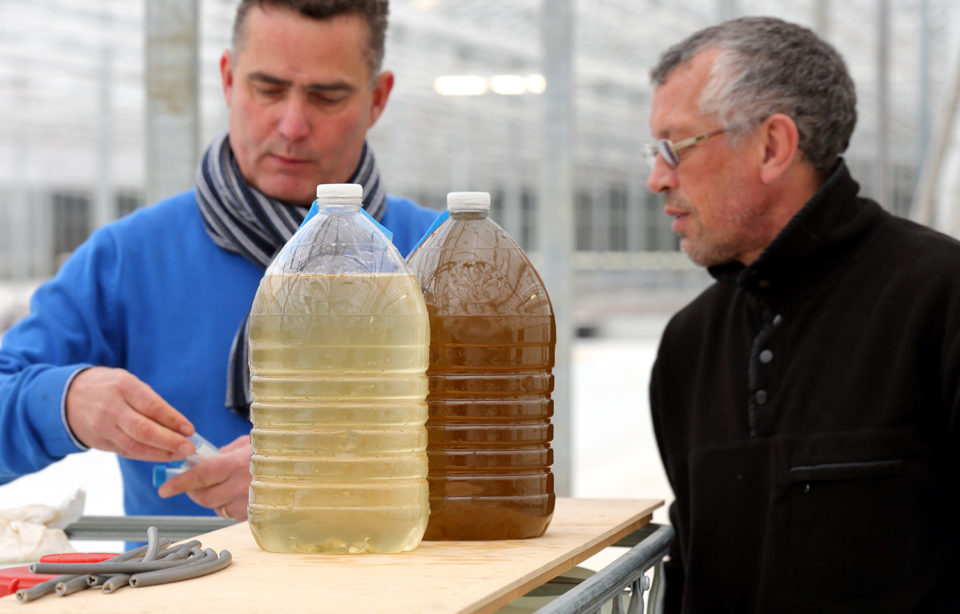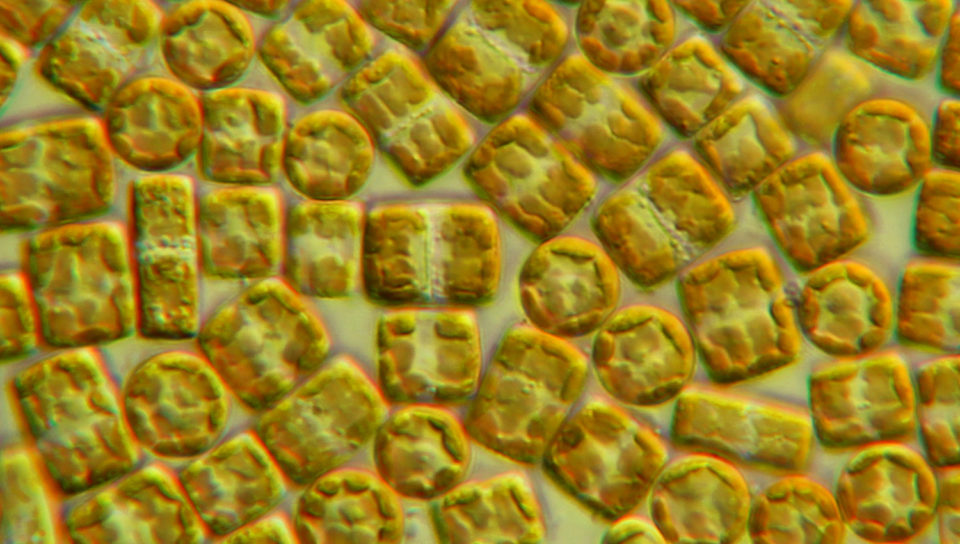Diatom product from TomAlgae, part of Benchmark Holdings, showing its versatility

A greenhouse company in Belgium believes its innovative shrimp feed product, made from freeze-dried microalgae, packs the crucial nutrients for the crustacean’s most vulnerable life stage: the first three days of its life.
This early stage of larval shrimp requires algae for feed. Current shrimp aquaculture practices typically also involve the production of live algae, typically on-site or from a neighboring facility.
But live algae is one of the principle vectors for bacteria and protozoal infections, which make shrimp farms susceptible to disease. William van der Riet, CEO of TomAlgae (a division of Benchmark Holdings) told the Advocate that his company’s freeze-dried microalgae product, developed in partnership with Bayer Animal Health about four years ago, can improve survival rates at hatcheries in a cost-effective manner.
“What makes it stand out are a few things, apart from the nutritional aspects,” said van der Riet. “It has the correct profile of polyunsaturated fatty acids, omega-3s, carotenoids and pigments. And it is the ideal size for ingestion for these small animals, 5 to 10 microns. There’s no manufactured diet of that precision, for that small of a scale.”
TomAlgae is now able to grow the diatom (van der Riet would not reveal the exact algae species, but that it is of the taxonomic order Thalassiosirales) on a large scale. But more important than scale is the timing – van der Riet says the first three days of a shrimp’s life are so important, shrimp hatcheries must have sufficient algae supplies on hand to keep them alive. Yet producing live algae, he added, can be unpredictable and result in inconsistent quality. Whether it’s a shrimp farm in Vietnam or an oyster farm in Scotland, expertise at any given aquaculture unit will be focused on production of those species, not algae, van der Riet argued.
“Cultures can crush very easily, and the ability to grow the amount of the right quality required for shrimp larvae can vary a lot,” he said.

Marketed in China and Thailand as Phylavive in a distribution agreement with Bayer, TomAlgae’s innovative product is freeze-dried, leaving the cell of the algae, a single-cell species, still intact.
“That’s the reason why freeze drying is part of the process. Freeze drying is a very gentle process; the algae is not damaged and the [polyunsaturated fatty acids] remain intact,” said van der Riet. Moreover, the product does not require cold storage. It simply sits on the shelf before undergoing a precise rehydration protocol.
A prominent shrimp producer in Southeast Asia, which requested anonymity, confirmed using the product for the past several years when there have been insufficient live algae supplies. The company is exploring ways to use it as a standalone, total replacement for live algae but its investments in live algae production do not justify it.
At TomAlgae we do not sell the biggest tonnes but the most critical ones.
The source also confirmed van der Riet’s contention that many shrimp hatcheries operate with survival rates below 40 percent, with heavy losses coming at the animals’ zoea and mysis stages, what is now being called Zoea Syndrome. This could be from contaminated algae produced at facilities with inadequate santitation and biosecurity.
Phylavive and Thalapure – the market name for the product outside of China and Thailand – is produced in a biosecure and isolated facility, using water that is free of pathogens, said van der Riet. The shelf-stable option represents a potentially large cost savings for shrimp producers, who can use the product when required, instead of rushing to feed shrimp when algae supplies are ready.
“In Thailand, it’s 90 percent live algae, and survival rates are 50 to 60 percent,” said van der Riet. “China is the other way around, with 10 to 15 percent live algae [usage] and the rest is ‘magic mixes.’ They get 10 to 15 percent survival rates, and are not looking at their processes to improve. They scale up their facilities, and instead of growing 100 million postlarvae, they grow 500 million postlarve. I reckon it’s the wrong strategy.”

The product is being used by some producers only during the shrimps’ first day as a “kickstarter” before continuing with live algae.
“It’s a management tool. We don’t think we can change immediately the practice of hatcheries growing live algae, which has been going on for years,” said van der Riet. “What we do see, the first step, is becoming part of the regular diet, or better feeding protocol. We’d like to come to a higher [inclusion] level, replacing the full live algae use.”
TomAlgae originally entered the ambitious F3 (Fish Free Feed) contest, which incentivized aquaculture feed producers to manufacture a feed using zero fishmeal or fish oil. The company soon became an “observer” to the process, van der Riet said, because it could not produce the massive volumes that other contestants could, using land-based crops and other alternative ingredients.
“At TomAlgae we do not sell the biggest tonnes but the most critical ones,” he added.
The company took part of its name from tomatoes, said van der Riet, as it was a “good reference back to the fact that we do it in a controlled greenhouse environment.” The company launched five years ago, and in search of capital to meet its growth plans it partnered with Benchmark in 2015 “to bring us to the next level.” Distribution outside of China and Thailand is being done in partnership with INVE Aquaculture, another Benchmark Holdings company.
Van der Riet said the emergence of alternative ingredients is extremely important, even though he identifies as a “relative outsider” to aquaculture.
“I do see there’s a lot to improve in the aquaculture value chain in terms of resource uses,” he said. “Fishmeal and fish oil products are still being used, but the trend is going down. I’m still quite stunned about how much is still needed. It’s not easy to mimic them with something else.”
In van der Riet’s view, after genetics and sound animal husbandry, aquaculture most needs improved biosecurity and customized feeding regimens. “To improve the whole industry, you need the next best step,” he said.
SaveSave
SaveSave
Author
-

James Wright
Editorial Manager
Global Aquaculture Alliance
Portsmouth, NH, USA[103,114,111,46,101,99,110,97,105,108,108,97,101,114,117,116,108,117,99,97,117,113,97,64,116,104,103,105,114,119,46,115,101,109,97,106]
Tagged With
Related Posts

Innovation & Investment
Aquafeed ingredient AlgaPrime wins GAA Innovation Award
A proliferation of alternative feed ingredients has allowed aquaculture to extend the natural resources it depends on. AlgaPrime, packed with the long-chain omega-3 fatty acid DHA, is being recognized as a game-changing innovation for aquaculture feeds.

Aquafeeds
Bridging the omega-3 gap with methane, microalgae
Innovation is leading to new ingredient options for renewable sources of omega-3 fatty acids. But Replicating long chain fatty acids is a tall order, Advocate contributor Lisa Duchene discovered.

Aquafeeds
Novel light bank reactor aids in microalgae culture
The control of temperature and light intensity in microalgae culture in outdoor tanks is difficult. Progress in algal biotechnology and the use of photo-bioreactors, metabolic engineering and other advances supported development of a novel underwater light bank reactor that allows for more effective light utilization by cultured microalgae.

Health & Welfare
Building a better shrimp nursery, part 1
Shrimp nursery systems offer an important opportunity to increase profits. Properly designed and operated nurseries are highly biosecure facilities to grow postlarvae at very high densities.

